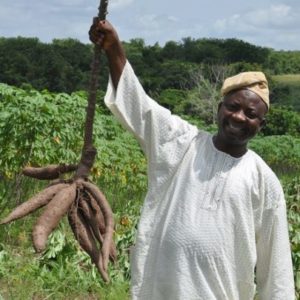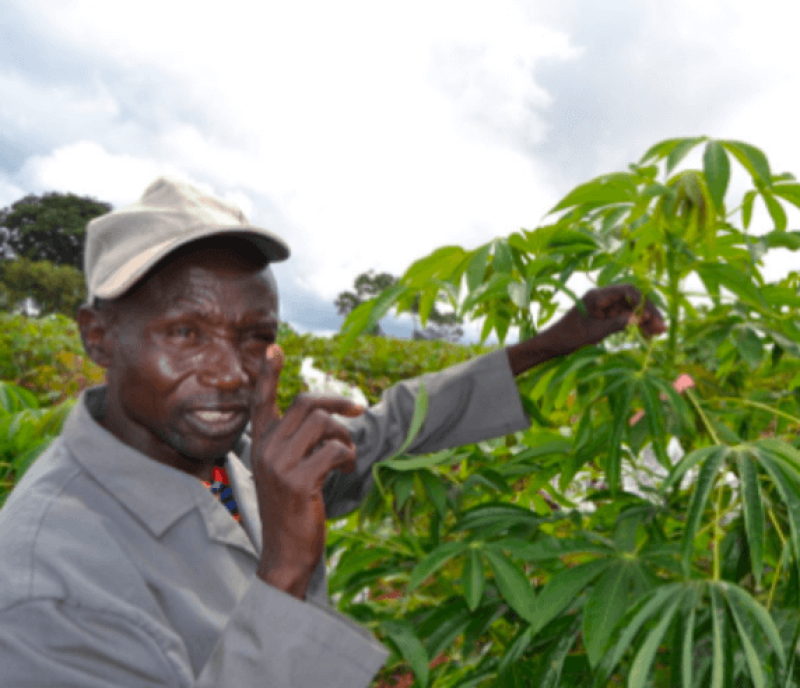In the developed world, most people eat the root vegetable cassava only in tapioca pudding or bubble tea. But in sub-Saharan Africa, it’s the primary staple for half a billion people and is the continent’s most popular crop. It has gained prominence due to its tolerance to extreme weather conditions, making it a reliable food security crop.
But it’s future is in danger. It is threatened by two viruses: brown streak (CBSD) and mosaic (CMD). It’s estimated that $1.25 billion worth of cassava plants succumb to the viruses every year. It is the

dream of farmers, scientists, and affected African governments to develop a variety that is resistant to both of these killer diseases.
Previous efforts through conventional breeding have resulted in several tolerant varieties. These conventionally bred varieties, however, succumb to the virus after a short time and do not stay long enough in the ground to take subsistence farmers through dry spells. Farmers tend to prefer varieties with tubers that remain in the ground for long periods of time without rotting.
Genetic solution?
In has stepped the Bill & Melinda Gates Foundation. The Foundation has released a $10.46 million grant through the Donald Danforth Plant Science Center for developing virus resistant cassava varieties. The project addressed varieties that would be grown in East Africa (virus resistance) and West Africa (virus resistance & nutrients enhancement).
According to the Danforth Center, VIRCA Plus –a collaborative project involving American and African institutions — will use the grant to further joint efforts towards delivering disease-resistant  cassava varieties. VIRCA Plus builds on the success of two predecessor projects: VIRCA project and BioCassava Plus project. The VIRCA project successfully developed varieties with strong and stable CBSD resistance in Kenya and Uganda. The two projects applied genetic engineering in developing these particular lines.
cassava varieties. VIRCA Plus builds on the success of two predecessor projects: VIRCA project and BioCassava Plus project. The VIRCA project successfully developed varieties with strong and stable CBSD resistance in Kenya and Uganda. The two projects applied genetic engineering in developing these particular lines.
This is the second major project financed by the Gates Foundation to attack these deadly viruses. Another variety for Nigeria –with elevated levels of iron and zinc, and resistant to viruses– is also under research. But tests so far show the African BioCassava Plus project has developed cassava plants that accumulate greater than 10 times more iron and zinc than comparable varieties in Nigeria. In January, Gates himself outlined this project:
In the developed world, most people eat the root vegetable cassava only in tapioca pudding or bubble tea. But in Africa, it’s the primary staple for half a billion people and the continent’s most popular crop. That’s why I’m super excited that scientists are using the most advanced hybridization techniques for the benefit of cassava farmers and those who depend on the crop. With the support of UK Department for International Development and our foundation, scientists are making great progress developing hybrids that are resistant to the major virus that cuts down on cassava yields (cassava mosaic virus). At the same time, these scientists are breeding strains that have more nutrients than the strains under cultivation today.
The joint efforts will not only involve partner institutions but will bring together conventional plant breeders and biotechnologists. One of the VIRCA Plus’ product development pathways is crossing the transgene resistant to brown streak virus with non transgenic varieties resistant to the mosaic virus in order to have a product resistant to both viruses. This decision meant VIRCA plus would need to employ the services of so-called human pollinators.
Human bees: Applying both conventional and genetic engineering breeding techniques
Some of the new breeding techniques that are being used on the transgenic crops are revolutionary. If breeding is the art and science of developing a new variety, then a special category of those involved in breeding, the pollinators or the “human bees”, fit in the “art” category. Unlike bees that visit flowers for nectar to feed the brood and carry along pollen that accidentally fertilize another flower, human pollinators are intentional. They must know the time of the day the female flower opens up to receive pollen. This time must not be missed as the gametes would eventually become nonviable. Pollinators ensure the “male” and the “female” flower about the same time to guarantee success. This, depending on the varieties under crossing, may require synchronized planting of the parental lines. Pollinators also keep records of where the pollen is coming from in order to maintain the integrity of the crosses.

Conventional breeding is more challenging for cassava pollinators because once they miss the chance of pollinating the flowers, either because the plants have flowered at different times or not flowered at all, they would have to wait for another flowering cycle or replant. Worse still, with one of the parents being transgenic, the research team might have to reapply again to government authorities for requisite permissions. This is costly in terms of time, deferred farmers’ expectations for solution, and additional financial burden on funding partners. A pollinator bears a big portion of these expectations and the pressure of making no mistakes.
14 years pollinating cassava
Solomon Agenoga is one of these “human bees” whose dream of a cassava variety resistant to cassava brown streak virus could be realized. He has been actively involved in the conventional breeding attempts that delivered different varieties to fight cassava brown streak disease at Uganda’s national cassava program based in Namulonge.
Solomon grew up seeing a cassava crop grow up healthy without any major problems. He has eaten cassava for over 40 years. He recalls the emergence of CMD that threatened to wipe out cassava in his village. Scientists eventually developed CMD-resistant varieties but before long CBSD struck and up to today no resistant variety has been released to farmers.
Solomon recalls, “when I was young, It never crossed my mind that one day I would get directly involved in improving my main staple for yield, pests and diseases.” For 14 years, Solomon has seen five different varieties released to farmers: NASE 14, NASE 16, NASE 19, NARO CAS1, NARO CAS2. To his disappointment, none of these varieties was resistant to both viruses. All of them are tolerant but not resistant. His full satisfaction will only come, he says, when a variety resistant to both mosaic virus and brown streak virus is developed. Following several conventional breeding attempts, only incorporating genetic engineering and conventional breeding approaches together could bring Solomon’s dream of a brown streak virus resistant variety into reality.
When the VIRCA project started in Solomon’s institution, there seemed to be irreconcilable differences between conventional breeding and genetic engineering. In fact, this technology that could do without flowers had a potential of rendering this experienced pollinator jobless. Solomon recalls, as a pollinator, in his mind, he could not imagine playing a role in this initiative that could help him save his childhood crop.
VIRCA Plus made a decision to incorporate conventional breeding techniques in its product development pathways. This decision elevated Solomon from being another pollinator to the key person who the project relied upon to deliver seeds of transgenic and non transgenic crosses. He rubbed shoulders with these “modern scientists” who transfer genes rather than pollen. He left his home in Uganda for the first time to pollinate cassava across the border. It then occurred to him that he was playing an important role in ensuring that millions of African farmers get to have a variety that is resistant to the deadly CBSD.
Solomon has done his best in leading a team of pollinators who, for the first time in their lives, make crosses involving a genetically modified parent working with a hybrid of conventional breeders and biotechnologists. According to Solomon, other than the additional regulatory procedures associated with transgenic crops, the steps involved were basically similar to the usual conventional breeding practices.
The Gates’ grant will not only unite scientists in rescuing millions of farm families from hunger due to crop failures, but could grant Solomon an opportunity to have a hand in saving his childhood crop from the viruses.
Isaac Ongu is an agriculturist, science writer and an advocate for science based interventions in solving agricultural challenges in Africa. Follow Isaac on twitter @onguisaac
For more background on the Genetic Literacy Project, read GLP on Wikipedia.































